|
|
| |
|
|
| |
|
|
|
|
| |
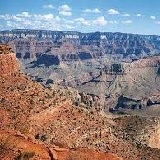 Travel
America Travel
America
Learn before you travel. This section of Fun Easy
English focuses on facts and other cool stuff about
your favorite U.S. state. This is great English
reading practice. This page focuses on the state of
Georgia. |
 Hey
if you cannot understand something on this page, Hey
if you cannot understand something on this page,
then use the Fun Easy English
dictionary
(opens in a new window) |
|
|
 Georgia Georgia
Known today as the "Peach State," Georgia, founded
in 1733, is one of the original 13 states. It was
named in honor of England's King George II. During
the Civil War, the fall of Atlanta was a crucial
turning point in the defeat of the South. Today,
Atlanta, which became Georgia's capital in 1868, is
a thriving city with major national corporations,
and it is considered the economic and cultural
center of the Southeast. The state flower is the
Cherokee rose. |
|
Georgia
State Flag
Georgia adopted a new state flag in 2003. Georgia's
current flag has three bars of equal width - two outer red
bars and a white bar in the center. There is a square blue
canton the width of two bars in the upper left corner.
Georgia's coat of arms is centered on the canton with the
words "In God We Trust" below (both in gold). The state coat
of arms is also the central design on the obverse [main
face] of Georgia's state seal. Circling the coat of arms are
thirteen white stars (symbols of Georgia and the other
twelve original states that formed the United States of
America).
Georgia leads the nation in the number and variety of
different state flags it has flown. |
|
Source:
State Symbols USA |
|
|
 Georgia
State Facts Georgia
State Facts
Picture: state seal of Georgia |
|
State Capital |
Atlanta |
|
Nickname |
Peach State / Goober state/ Empire State of the
South |
|
Motto |
Wisdom, justice, and moderation |
|
Statehood |
January 2, 1788 (4th) |
|
Origin of Name |
Named for King George II of England. |
|
Largest Cities |
Atlanta, Columbus, Savannah, Macon, Albany |
|
Border States |
Alabama, Florida, North Carolina, South Carolina,
Tennessee |
|
Area |
57,919 sq. mi.; 21st largest |
|
State Bird |
Brown Thrasher |
|
State Flower |
Cherokee Rose (rosa laevigata) |
|
State Tree |
Live oak (quercus virginiana) |
|
State Song |
Georgia on My Mind |
 Travel and tourism site for Georgia - This
state travel and territorial tourism site provides ideas for your
vacations, meetings, and more. Travel and tourism site for Georgia - This
state travel and territorial tourism site provides ideas for your
vacations, meetings, and more. |
|
|
Georgia Stories |
|
|
Gold Rush Days / World Open Gold Panning
Championship
You've probably heard of the California Gold Rush of 1848. But did
you know there was also a gold rush in Georgia?
Gold was discovered in Dahlonega, Georgia, in 1828. Nestled in the
mountains of northern Georgia, Dahlonega is home to the Consolidated
Gold Mine. At the turn of the 20th century, the mine was reportedly
the largest gold mining operation east of the Mississippi River. In
1901, during a cleanup, 54 pounds of gold were recovered from it.
Each October, Dahlonega, which comes from the Indian word "talonaga,"
meaning "precious metal," celebrates the first big gold rush with a
two-day festival that has grown into one of the biggest events in
the area. Another festival, called the World Open Gold Panning
Championship, began in California in 1961 to remember the 1842
discovery of gold in Los Angeles County. This festival moved to the
Consolidated Gold Mine in Dahlonega in the late 1980s. The
Championship includes a contest in which the winner is the fastest
person to pan eight nuggets of gold from a full pan of sand. How
long do you think it would take you to pan gold nuggets? |
|
|
Westville Yule Log Ceremony
Ever wondered what a Southern country village was like in the 1800s?
If you were to visit Westville Village in Georgia, you would get a
good idea. Called a "living history museum," Westville Village is a
town completely restored to what it was like in 1850 -- with
authentic pre-Civil War-era buildings. The entire town is a museum
of what life was like in the mid-19th century.
Today, visitors to Westville can observe craftspeople practicing
their trades, such as blacksmithing, pottery, basket-making,
spinning, weaving, farming, fireplace cooking, candle-making and lye
soap-making.
The village also revives old holiday traditions. At Christmastime
one of the celebrations is a Yule Log ceremony. On Christmas Eve a
large, freshly cut log is decorated and brought to a fireplace.
Prayers are then recited while the log is sprinkled with oil, salt,
and special wine and then lit. It was believed that the remains of
the burned log would protect the house from lightning and evil
powers. This custom dates back to the 12th century and was known in
most European countries before it became popular in the U.S. |
|
|
Prater's Mill
Twice a year Northwestern Georgia celebrates its cultural traditions
on the grounds of a historic water-powered mill. The Prater Mill,
located on the Coahulla Creek, was built by Benjamin Franklin Prater
in 1855. During the Civil War, the mill was used as a campsite for
soldiers on both sides. Since it was considered an important source
of food, it was not destroyed. The Prater family operated the mill
until the 1950s.
On Mother's Day and Columbus Day weekends, the mill goes back into
operation by grinding yellow and white cornmeal. Other old-time
industries are demonstrated during these weekends, such as
blacksmithing and the making of furniture and musical instruments.
One of these instruments is the dulcimer, a type of stringed
instrument on which the strings are beaten with a small hammer
rather than plucked.
Traditional Southern foods such as hoecakes and poke salad are
served at these festivals, and Appalachian music is performed.
Hoecakes are made of cornmeal shaped into a flat cake and baked or
fried on a griddle. The hoecake got its name because it was
sometimes baked on the blade of a hoe. Poke salad is made of a
vegetable that grows wild in the eastern United States. |
|
|
Georgia Folk Pottery
Have you ever made a pot out of clay? In Georgia the creation of
pottery has a long history. The red clay of north Georgia soil is
highly suitable for pottery making. American Indians in the area,
including the Creeks and Cherokees, created clay wares, and as
European immigrants settled in Georgia during the 1700s, they too
made pottery.
The European immigrants made pottery by turning clay on a wheel
(called "throwing"), using glaze and a fire kiln (oven). Pottery
became so widespread in the 1820s through the 1840s in the north and
central areas of Georgia that pottery-making centers were called "jugtowns."
Today, Georgia pottery is still made, and the skills, techniques,
and materials are passed on to each new generation. Several families
in this area continue to "turn and burn," preserving a 200-year-old
tradition.
With few exceptions, Georgia pottery was produced for practical uses
only, and any artistic appeal was secondary. This does not mean
Georgia pottery lacks beauty. It is the combination of form and
glaze, and technique and innovation that creates a simple beauty. |
|
|
Swamp Gravy
Why does the woman in the photo have pots and pans balancing on her
head? She's performing in Swamp Gravy.
No, it's not a big swamp filled with your mother's turkey gravy!
Swamp Gravy: The Gospel Truth is a play. Swamp Gravy tells real-life
stories of everyday people in the form of comedies, dramas and even
musicals. The stories come from taped interviews, which a writer
then adapts into a play. Each year there is a new version of the
play with new stories. The stories are about life and death, family,
and community.
More than 100 volunteers -- actors and production crew -- produce
this play and bring these stories to life. It is of such
professional quality that the Georgia General Assembly has called it
the "Official Folk Life Play of Georgia."
In addition to performing at the Cotton Hall (a renovated cotton
warehouse in Colquitt, Georgia), Swamp Gravy was selected to be
performed at the Kennedy Center in Washington, D.C. The crowd was so
moved by the performance that the cast was invited to return. Next
time Swamp Gravy will have new stories of Georgia life. |
|
|
Atlanta's Role in the Civil War
Atlanta played an important role during the Civil War. Do you know
what it was?
Founded in 1837 as a railway center for northwestern Georgia,
Atlanta's original name was "Terminus." By 1852, its population had
reached 3,000, including some 500 slaves. Because of its location
and commercial importance, Atlanta was used as a center for military
operations and as a supply route by the Confederate army during the
Civil War. Therefore, it also became a target for the Union army.
General William Tecumseh Sherman and his troops captured the city in
1864. In order to weaken the Confederate military organization,
Union troops burned Atlanta to the ground before they moved on. Do
you think that burning the city was an extreme action?
Today, Atlanta is the capital of Georgia. It is known for its robust
economy and as the birthplace of Martin Luther King Jr. |
|
|
Juliette Gordon Low, Girl Scout National
Center
Are you a Girl Scout or a Boy Scout? Do you know where the idea for
these troops came from? The original idea came from England, but the
first Girl Scout group in the United States began in Savannah,
Georgia, and all because one woman had a vision.
Juliette "Daisy" Gordon Low organized the first group of Girl Scouts
on March 12, 1912, because she wanted to give girls the opportunity
to get out of the house and get involved in their community and the
outdoors. She got the idea of starting a girl's group after spending
time in England with General Robert Baden-Powell and his sister
Agnes, who had founded the Boy Scouts and the Girl Guides.
Low took these ideas back to the U.S. and established the Girl
Guides of America. It started out as a group of 18 girls who met
regularly with a naturalist to go on nature walks, cook meals over
campfires, and do other "scouting" activities. Low was so dedicated
to this group that she sold a strand of rare matched pearls for
$8,000 to pay for operations in the beginning. Today, Low's
birthplace in Savannah is open to the public as a museum and
contains information about the early Girl Scouts. |
|
Source:
Library of Congress |
|
 National
Forests and Monuments of Georgia National
Forests and Monuments of Georgia
The following is a description of national
forests and monuments in the state
of Georgia. There are no national parks in
this state. If you plan to visit or live in
Georgia for awhile then you should
definitely plan to visit some of these
fantastic places. |
|
|
|
National Forests |
 Chattahoochee-Oconee Chattahoochee-Oconee
With 430 mi (690 km) of trails, this forest
contains the southern terminius of the
Appalachian Trail. Georgia's highest point,
Brasstown Bald at 4,784 ft (1,458 m) is in
the forest, and several Civil War battles
were fought in the area. |
|
|
|
National Monuments |
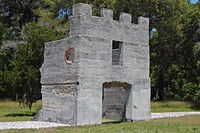 Fort
Frederica Fort
Frederica
Built by James Oglethorpe between 1736 and
1748, these remnants of a fort and town
protected the southern boundary of the
British colony of Georgia from Spanish
raids. It was a few miles from the site of
the Battle of Bloody Marsh. |
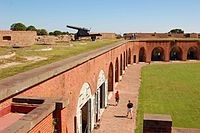 Fort
Pulaski Fort
Pulaski
In 1862 during the American Civil War, the
Union Army successfully tested a rifled
cannon against the defending Confederates,
rendering brick fortifications obsolete.
Fort Pulaski was also used as a
prisoner-of-war camp during the war. The
national monument includes most of Cockspur
Island (containing the fort) and all of
adjacent McQueens Island. |
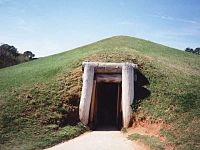 Ocmulgee Ocmulgee
Ocmulgee preserves traces of more than 10
millennia of native Southeastern culture,
including Mississippian mounds. From Ice Age
hunters to the Creek Indians of historic
times, there is evidence of at least 10,000
years of human habitation. Between 900 and
1150, an elite society supported by skillful
farmers lived on this site near the Ocmulgee
River. |
|
|
|
|
|
|
|
|
|
|
|
|
Cool America |
 About the U.S.A. About the U.S.A.
About the U.S.A. is an American
Studies reader that examines the customs, government, and history of the
United States of America. The text provides a wealth of information on U.S.
geography and history; the roles of local, state, and federal government;
national holidays and symbols; the Constitution; and citizenship. The book,
which was written for intermediate to advanced learners of English, contains
a range of activities for language students to practice listening, speaking,
reading, and writing. (opens to a new PDF window)
Great English reading
practice. |
 About
America About
America
Learn about the fascinating history and government of
the United States of America. Lessons include content on
American Government, American History, and Integrated
Civics. Handouts with interactive games and
student-centered activities encompass all four language
skills: speaking, listening, reading, and writing.
Great English reading practice for
beginning to intermediate students. |
 American Teens Talk! American Teens Talk!
Americans Teens Talk! is a collection of interviews of
American high school students. Each interview is accompanied by vocabulary
notes and discussion questions. The interviews in American Teens Talk! give
learners a view into the lives of adolescents in the U.S. Through the
written format of the interviews, learners are able to increase their
vocabulary, practice their reading and listening skills, engage in
discussions, and learn more about U.S. culture. These
interviews come with audio programs.
Great English listening and
reading |
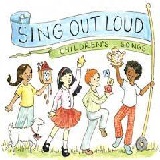 Sing Out Loud Children's Songs Sing Out Loud Children's Songs
Sing Out Loud Children's Songs includes popular children's songs in the U.S.A. Posters accompany the
individual Sing Out Loud Children's Songs. These
songs come with audio programs.
Great English listening and reading
practice. |
 Sing Out Loud Traditional Songs Sing Out Loud Traditional Songs
The Sing Out Loud Traditional Songs
collection contains 13 traditional American folk songs and song lyrics.
Listen to the songs online, read the lyrics, and collect the posters that
accompany the songs. These
songs come with audio programs.
Great English listening and reading
practice. |
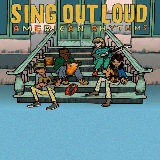 Sing Out Loud American Rhythms Sing Out Loud American Rhythms
Do you love music? Want to use it
to learn English? Check out the hip-hop inspired song "Peace" from Sing Out
Loud American Rhythms. American Rhythms includes a variety of musical genres
from many different artists in the U.S.A. These songs will appeal to teens
and young adults. These
songs come with audio programs.
Great English listening and reading
practice. |
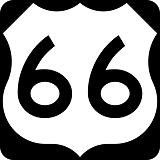 Route
66 - Famous American Road Route
66 - Famous American Road
U.S. Route 66 (US 66 or Route 66), also known as the Will Rogers Highway, the
Main Street of America or the Mother Road, was one of the original highways in
the U.S. Highway System. The highway, which became one of the most famous roads
in the United States, originally ran from Chicago, Illinois, through Missouri,
Kansas, Oklahoma, Texas, New Mexico, and Arizona before ending in Santa Monica,
California, near Los Angeles, covering a total of 2,448 miles (3,940 km). It was
recognized in popular culture by both the hit song "(Get Your Kicks on) Route
66" and the Route 66 television show in the 1960s. |
Route 66: The Highway That's the Best
(Beginner - Listening)
A video lesson which shows you an interesting place in America.
The English is
spoken at 75% of normal speed.
Great English listening practice.
This video shows travel along Route 66, the most famous road in
America. |
Chicago: The Start of Route 66
(Beginner - Listening)
A video lesson which shows you an interesting place in America.
The English is
spoken at 75% of normal speed.
Great English listening practice.
This video shows travel along Route 66, the most famous road in
America. |
Going West for Decades on Route 66
(Beginner - Listening)
A video lesson which shows you an interesting place in America.
The English is
spoken at 75% of normal speed.
Great English listening practice.
This video shows travel along Route 66, the most famous road in
America. |
Arizona: The Spirit of Route 66
(Beginner - Listening)
A video lesson which shows you an interesting place in America.
The English is
spoken at 75% of normal speed.
Great English listening practice.
This video shows travel along Route 66, the most famous road in
America. |
Route 66 California: The End of the Trail
(Beginner - Listening)
A video lesson which shows you an interesting place in America.
The English is
spoken at 75% of normal speed.
Great English listening practice.
This video shows travel along Route 66, the most famous road in
America. |
Ten Must-See Route 66 Attractions
(Beginner - Listening)
A video lesson which shows you an interesting place in America.
The English is
spoken at 75% of normal speed.
Great English listening practice.
This video shows travel along Route 66, the most famous road in
America. |
Four Famous Foods On Route 66
(Beginner - Listening)
A video lesson which shows you an interesting place in America.
The English is
spoken at 75% of normal speed.
Great English listening practice.
This video shows travel along Route 66, the most famous road in
America. |
International Tourists Drawn to Route 66
(Beginner - Listening)
A video lesson which shows you an interesting place in America.
The English is
spoken at 75% of normal speed.
Great English listening practice.
This video shows travel along Route 66, the most famous road in
America. |
|
|
|
|
Search Fun Easy English |
|
|
|
|
|
|
|
|
|
|
|
|
|
|
|
About
Contact
Copyright
Resources
Site Map |